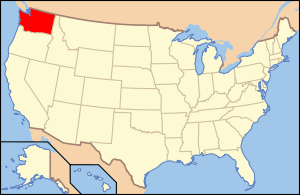Arthur Foss
|
Arthur Foss (tugboat) | |
|
Arthur Foss | |
| Location | Maritime Heritage Center, 1002 Valley Dr., Seattle |
|---|---|
| Coordinates | 47°37′41.31″N 122°20′12.72″W / 47.6281417°N 122.3368667°WCoordinates: 47°37′41.31″N 122°20′12.72″W / 47.6281417°N 122.3368667°W |
| Built | 1889 |
| Architect | Oregon Railway & Navigation Co. |
| NRHP Reference # | 89001078 |
| Significant dates | |
| Added to NRHP | April 11, 1989[1] |
| Designated NHL | April 11, 1989[2] |
| Designated SEATL | March 14, 1977[3] |
Arthur Foss, built in 1889, originally named Wallowa,[4] is one of the oldest wooden-hulled tugboats afloat in the United States. In 1898, in response to the Alaskan gold rush, she transported barges full of gold-seeking miners and supplies up the Inside Passage. There are no other Alaskan Gold Rush vessels still operating today. She was cast by the Metro-Goldwyn-Mayer movie studio to play in its 1933 production Tugboat Annie.[5][6]
In February 1941 Arthur Foss was sent under charter agreement with Contractors, Pacific Naval Air Bases[7] to Wake Island for construction of harbors and air bases. In March she was joined by Justine Foss at Wake. Arthur Foss, under Captain Oscar Rolstad, was assigned the task of towing barges loaded with supplies and construction equipment from Honolulu and was returning to Honolulu with two 1,000 ton barges and twelve hours out of Wake when the news of the attack on Pearl Harbor was received. Painted white and highly visible the ship was a likely target standing "out like a chain of coral islands on the empty sea" and, despite some discussion of heading for Alaska, the ship continued to Pearl Harbor under radio silence. The ship was spotted by naval scout planes and escorted into Pearl Harbor 28 December 1941 where Admiral Claude Bloch cited the crew for action beyond the call of duty.[8] Arthur Foss was the last vessel to escape Wake Island before Imperial Japanese forces captured the island on 23 December 1941.[4][9] She thus escaped the fate of Justine Foss that was captured, forced to serve Japanese purposes and then scuttled with members of her crew executed along with many of the other civilian contractors held captive.[8] Arthur Foss was acquired by the US Navy in 1942, renamed Dohasan and designated YT-335 and later YTM-335.[10] In 1946 the tug was returned to Foss Towing and Barge Co. and renamed Arthur Foss.[10]
In 1948 the tug was assigned the task of towing log cribs and later bundled log rafts in the Strait of Juan de Fuca continuing this work until retirement in 1968 to set the record for the longest uninterrupted log-towing service in the Straits.[5][11]

Arthur Foss has a six-cylinder, 700 horsepower (520 kW) diesel engine. Her top speed is 13 knots (24 km/h). The vessel is 111.6 feet (34.0 m) long with a beam of 23.9 feet (7.3 m) and a draft of 15 feet (4.6 m). When last operated the vessel was owned by Foss Launch and Tug Company (now Foss Maritime) who donated her to Northwest Seaport in 1970. Northwest Seaport renovated her in 2004.[12] The vessel was declared a National Historic Landmark in 1989[2][4] and is a city landmark as well.[13] and a featured attraction at Seattle's new South Lake Union Park. The vessel is open for public tours on most summer weekends, or by appointment.[14]
See also
| Wikimedia Commons has media related to Arthur Foss (tugboat, 1889). |
References
- ↑ National Park Service (2007-01-23). "National Register Information System". National Register of Historic Places. National Park Service.
- 1 2 "ARTHUR FOSS (Tugboat)". National Historic Landmark summary listing. National Park Service. Archived from the original on 30 January 2008. Retrieved 2008-03-01.
- ↑ "Landmarks A-Z". City of Seattle. Retrieved 2013-03-05.
- 1 2 3 Delgado, James P. (1988). "Tugboat Arthur Foss, ex-Wallowa National Historic Landmark Study". National Park Service. Retrieved 1 April 2013.and
—— (July 9, 1988). "Accompanying five photos, exterior and interior, from 1988" (pdf). National Park Service. Retrieved 2012-08-22. - 1 2 "Museum Ship: Visit Tugboat Arthur Foss". Northwest Seaport Maritime Heritage Center. 22 March 2013. Retrieved 1 April 2013.
- ↑ Burrows, Alyssa (1 February 2007) [2002]. "Filmography in Seattle". HistoryLink.
- ↑ Contractors, Pacific Naval Air Bases
- 1 2 Skalley, Mike (June 2010). "The Arthur Foss Escaped to Hawaii, But the Justine Foss Was Caught in the Japanese Invasion of Wake Island" (pdf). The Look Aft. Tow Bitts. Foss Maritime. 23 (2): 18–19.
- ↑ ["Archived copy". Archived from the original on 2 January 2013. Retrieved 2013-04-03. "Wake Island"] Check
|url=value (help). Dictionary of American Naval Fighting Ships. Navy Department, Naval History & Heritage Command. Retrieved 3 April 2013. - 1 2 Photo gallery of Dohasan (YTM-335) at NavSource Naval History
- ↑ Skalley, Mike (September 2010). "Logs Brought Foss to Neah Bay in the 1920s" (pdf). The Look Aft. Tow Bitts. Foss Maritime. 23 (3): 19. Retrieved 3 April 2013.
- ↑ "Arthur Foss". Maritime Heritage Network. Retrieved 1 March 2008.
- ↑ Landmarks Alphabetical Listing for T Archived 9 February 2012 at the Wayback Machine., Individual Landmarks, Department of Neighborhoods, City of Seattle. Accessed 28 December 2007.
- ↑ "Historic Fleet: Tugboat Arthur Foss". Northwest Seaport. Archived from the original on 2009-07-27.
External links
- Northwest Seaport
- HNSA Web Page: Tug Arthur Foss
- The Center for Wooden Boats
- National Register of Historic Places Registration: Arthur Foss, ex-Wallowa / Tugboat Arthur Foss (National Register of Historic Places Registration Form July 9, 1988 including James P. Delgado's report and other information.)
- Dictionary of American Naval Fighting Ships: Dohasan
- Pearl Harbor and the Outlying Islands: US Navy Base Construction in World War II
- Massacre on Wake Island


